Wireless Networking Report: Antenna, Protocols, and Research Analysis
VerifiedAdded on 2020/11/12
|12
|2843
|419
Report
AI Summary
This report provides a comprehensive overview of wireless networking, encompassing various antenna types such as Yagi, horn, and cellular antennas, detailing their strengths and weaknesses. It also examines three distinct wireless network protocols: Bluetooth, Wireless Application Protocol (WAP), and Wi-Fi, analyzing their functionalities, advantages, and limitations. Furthermore, the report delves into the security challenges associated with each protocol, including vulnerabilities like DOS attacks, unauthenticated alert messages, and misconfigured access points. The report also includes a critical reflection of two research papers. The first research paper focuses on Software Defined Wireless Networking (SDWN), exploring its architecture, advantages like virtualization and QoE aware network operation, and the evolutionary and clean state deployment models. The second research paper surveys the challenges in handling traffic on wireless networks and the use of paradigms like Software Defined Networking (SDN) and Network Function Virtualization (NFV) to overcome them.
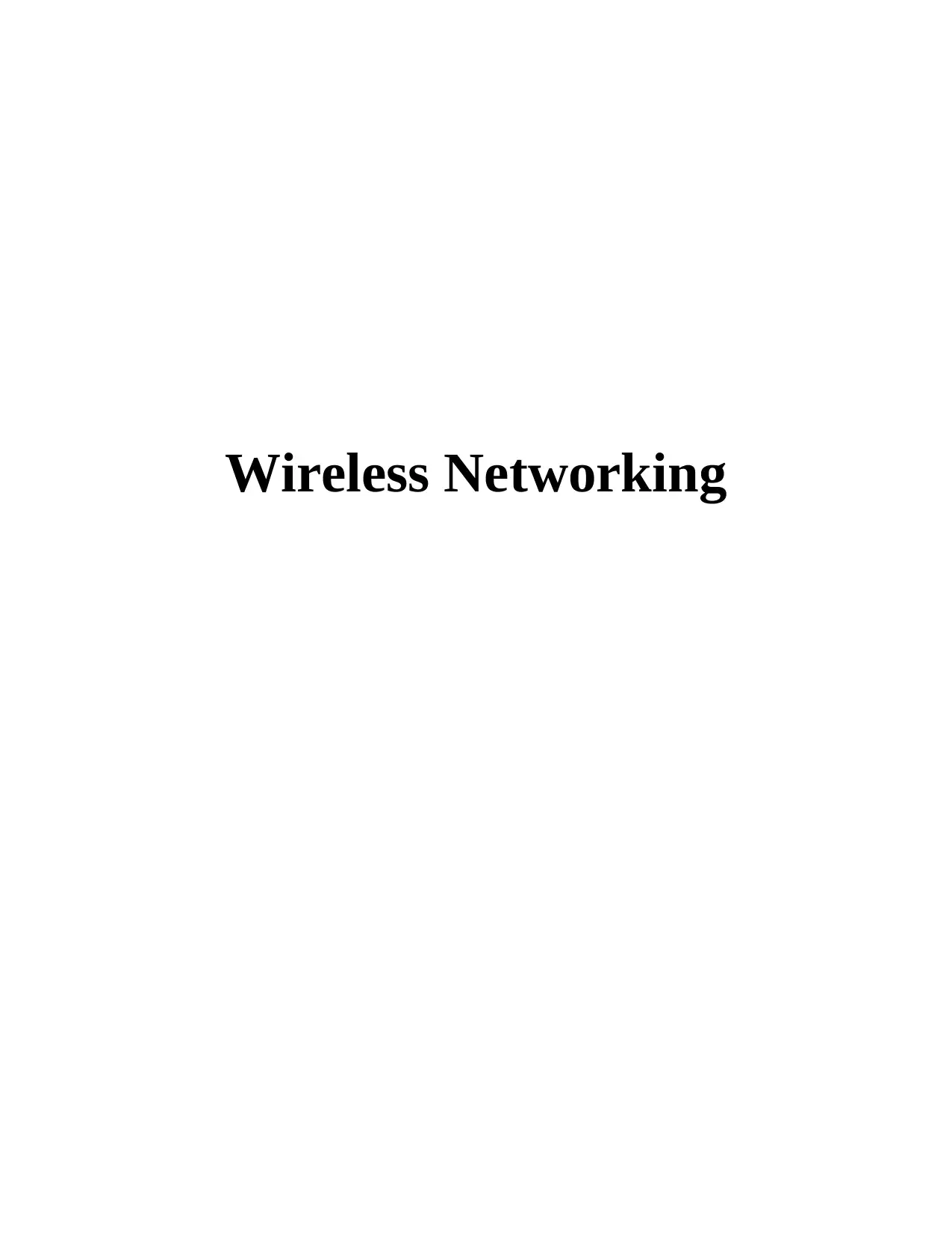
Wireless Networking
Paraphrase This Document
Need a fresh take? Get an instant paraphrase of this document with our AI Paraphraser

TABLE OF CONTENTS
INTRODUCTION...........................................................................................................................1
TASK 1............................................................................................................................................1
1) Explain different antenna, such as yagi, horn, and cellular antennas and their strengths and
weakness.....................................................................................................................................1
2) Explain any three different wireless network protocols in details and how they are used as
well their strengths and weakness...............................................................................................3
3) Critical reflection of research papers......................................................................................6
CONCLUSION................................................................................................................................8
REFERENCES................................................................................................................................9
INTRODUCTION...........................................................................................................................1
TASK 1............................................................................................................................................1
1) Explain different antenna, such as yagi, horn, and cellular antennas and their strengths and
weakness.....................................................................................................................................1
2) Explain any three different wireless network protocols in details and how they are used as
well their strengths and weakness...............................................................................................3
3) Critical reflection of research papers......................................................................................6
CONCLUSION................................................................................................................................8
REFERENCES................................................................................................................................9
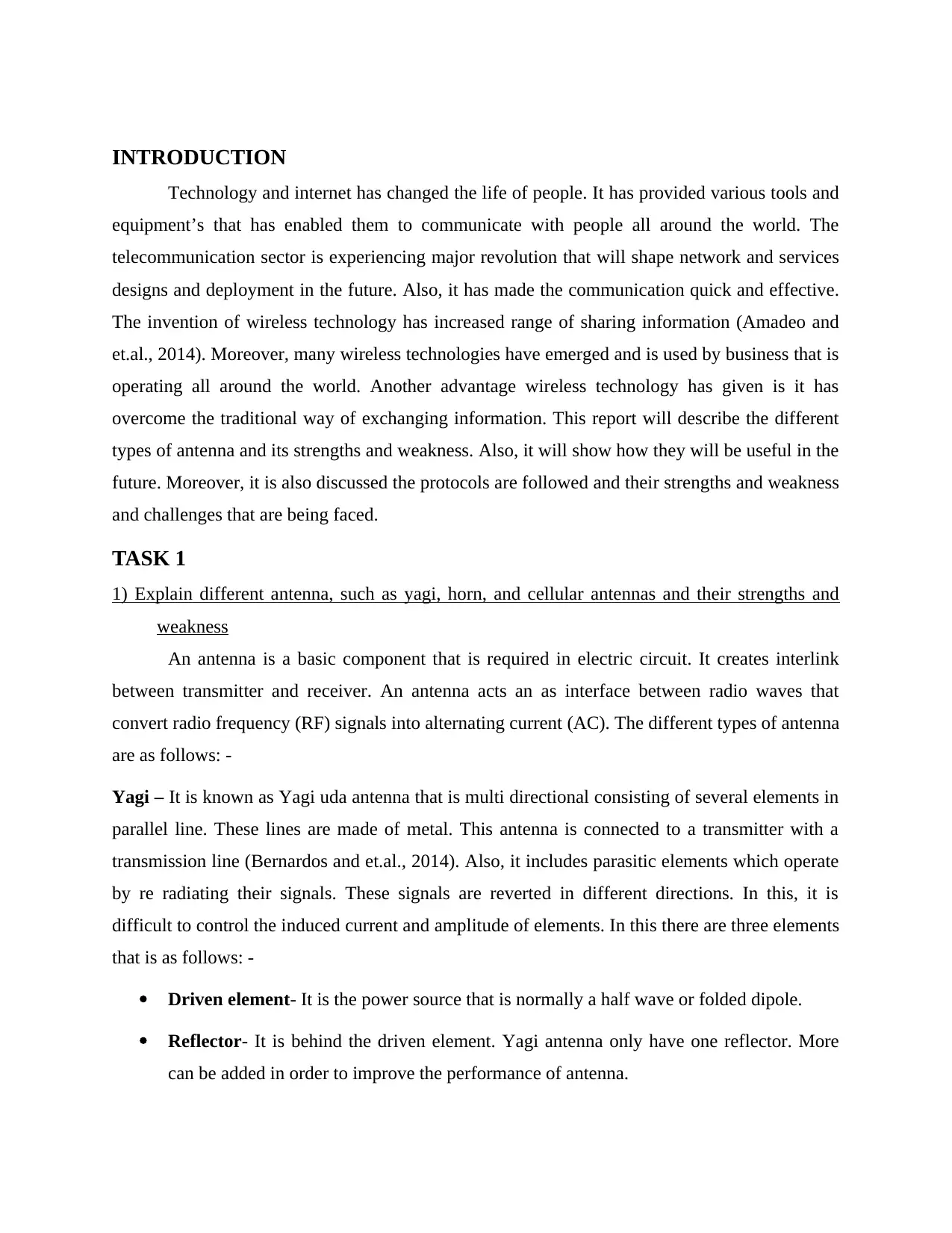
INTRODUCTION
Technology and internet has changed the life of people. It has provided various tools and
equipment’s that has enabled them to communicate with people all around the world. The
telecommunication sector is experiencing major revolution that will shape network and services
designs and deployment in the future. Also, it has made the communication quick and effective.
The invention of wireless technology has increased range of sharing information (Amadeo and
et.al., 2014). Moreover, many wireless technologies have emerged and is used by business that is
operating all around the world. Another advantage wireless technology has given is it has
overcome the traditional way of exchanging information. This report will describe the different
types of antenna and its strengths and weakness. Also, it will show how they will be useful in the
future. Moreover, it is also discussed the protocols are followed and their strengths and weakness
and challenges that are being faced.
TASK 1
1) Explain different antenna, such as yagi, horn, and cellular antennas and their strengths and
weakness
An antenna is a basic component that is required in electric circuit. It creates interlink
between transmitter and receiver. An antenna acts an as interface between radio waves that
convert radio frequency (RF) signals into alternating current (AC). The different types of antenna
are as follows: -
Yagi – It is known as Yagi uda antenna that is multi directional consisting of several elements in
parallel line. These lines are made of metal. This antenna is connected to a transmitter with a
transmission line (Bernardos and et.al., 2014). Also, it includes parasitic elements which operate
by re radiating their signals. These signals are reverted in different directions. In this, it is
difficult to control the induced current and amplitude of elements. In this there are three elements
that is as follows: -
Driven element- It is the power source that is normally a half wave or folded dipole.
Reflector- It is behind the driven element. Yagi antenna only have one reflector. More
can be added in order to improve the performance of antenna.
Technology and internet has changed the life of people. It has provided various tools and
equipment’s that has enabled them to communicate with people all around the world. The
telecommunication sector is experiencing major revolution that will shape network and services
designs and deployment in the future. Also, it has made the communication quick and effective.
The invention of wireless technology has increased range of sharing information (Amadeo and
et.al., 2014). Moreover, many wireless technologies have emerged and is used by business that is
operating all around the world. Another advantage wireless technology has given is it has
overcome the traditional way of exchanging information. This report will describe the different
types of antenna and its strengths and weakness. Also, it will show how they will be useful in the
future. Moreover, it is also discussed the protocols are followed and their strengths and weakness
and challenges that are being faced.
TASK 1
1) Explain different antenna, such as yagi, horn, and cellular antennas and their strengths and
weakness
An antenna is a basic component that is required in electric circuit. It creates interlink
between transmitter and receiver. An antenna acts an as interface between radio waves that
convert radio frequency (RF) signals into alternating current (AC). The different types of antenna
are as follows: -
Yagi – It is known as Yagi uda antenna that is multi directional consisting of several elements in
parallel line. These lines are made of metal. This antenna is connected to a transmitter with a
transmission line (Bernardos and et.al., 2014). Also, it includes parasitic elements which operate
by re radiating their signals. These signals are reverted in different directions. In this, it is
difficult to control the induced current and amplitude of elements. In this there are three elements
that is as follows: -
Driven element- It is the power source that is normally a half wave or folded dipole.
Reflector- It is behind the driven element. Yagi antenna only have one reflector. More
can be added in order to improve the performance of antenna.
⊘ This is a preview!⊘
Do you want full access?
Subscribe today to unlock all pages.

Trusted by 1+ million students worldwide
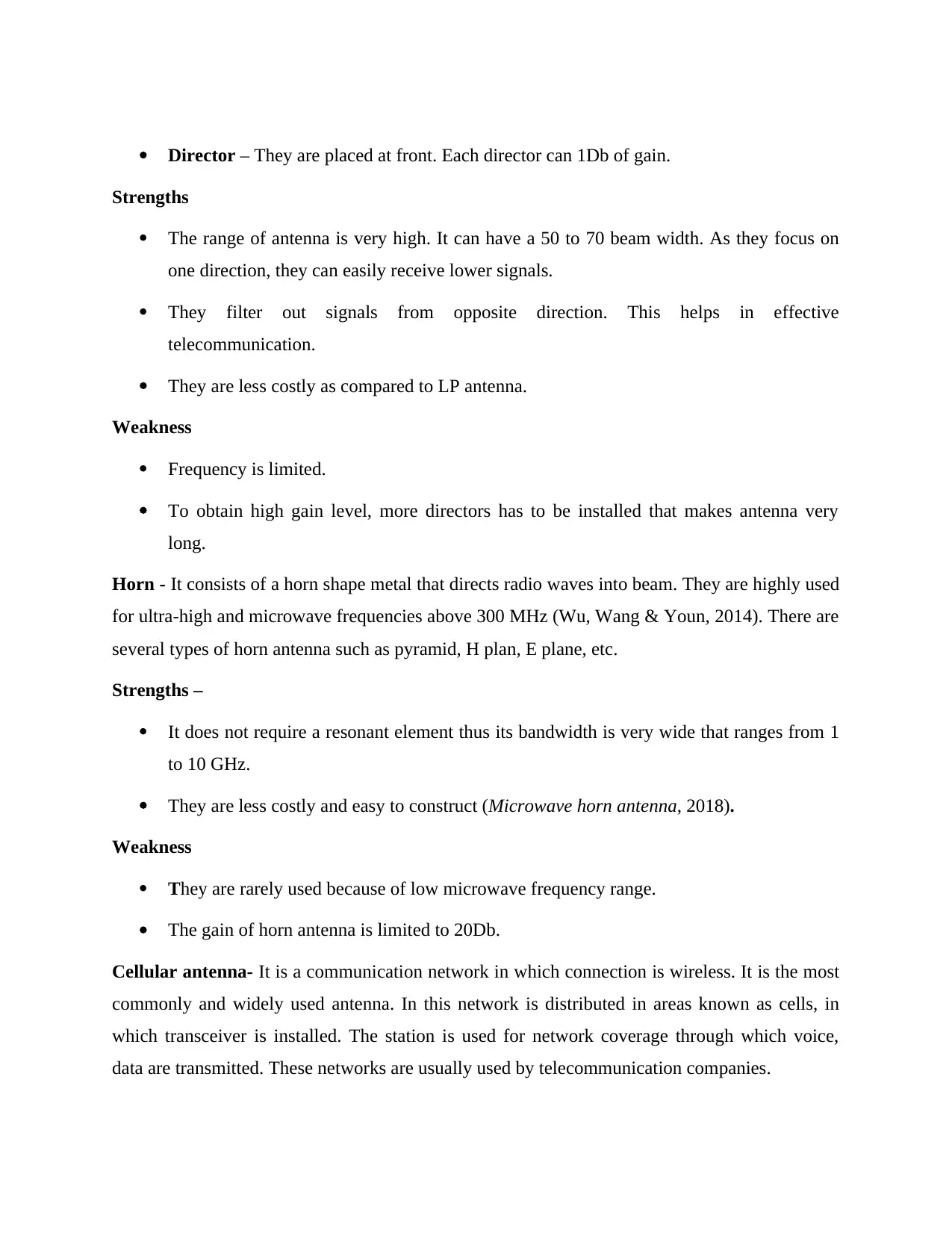
Director – They are placed at front. Each director can 1Db of gain.
Strengths
The range of antenna is very high. It can have a 50 to 70 beam width. As they focus on
one direction, they can easily receive lower signals.
They filter out signals from opposite direction. This helps in effective
telecommunication.
They are less costly as compared to LP antenna.
Weakness
Frequency is limited.
To obtain high gain level, more directors has to be installed that makes antenna very
long.
Horn - It consists of a horn shape metal that directs radio waves into beam. They are highly used
for ultra-high and microwave frequencies above 300 MHz (Wu, Wang & Youn, 2014). There are
several types of horn antenna such as pyramid, H plan, E plane, etc.
Strengths –
It does not require a resonant element thus its bandwidth is very wide that ranges from 1
to 10 GHz.
They are less costly and easy to construct (Microwave horn antenna, 2018).
Weakness
They are rarely used because of low microwave frequency range.
The gain of horn antenna is limited to 20Db.
Cellular antenna- It is a communication network in which connection is wireless. It is the most
commonly and widely used antenna. In this network is distributed in areas known as cells, in
which transceiver is installed. The station is used for network coverage through which voice,
data are transmitted. These networks are usually used by telecommunication companies.
Strengths
The range of antenna is very high. It can have a 50 to 70 beam width. As they focus on
one direction, they can easily receive lower signals.
They filter out signals from opposite direction. This helps in effective
telecommunication.
They are less costly as compared to LP antenna.
Weakness
Frequency is limited.
To obtain high gain level, more directors has to be installed that makes antenna very
long.
Horn - It consists of a horn shape metal that directs radio waves into beam. They are highly used
for ultra-high and microwave frequencies above 300 MHz (Wu, Wang & Youn, 2014). There are
several types of horn antenna such as pyramid, H plan, E plane, etc.
Strengths –
It does not require a resonant element thus its bandwidth is very wide that ranges from 1
to 10 GHz.
They are less costly and easy to construct (Microwave horn antenna, 2018).
Weakness
They are rarely used because of low microwave frequency range.
The gain of horn antenna is limited to 20Db.
Cellular antenna- It is a communication network in which connection is wireless. It is the most
commonly and widely used antenna. In this network is distributed in areas known as cells, in
which transceiver is installed. The station is used for network coverage through which voice,
data are transmitted. These networks are usually used by telecommunication companies.
Paraphrase This Document
Need a fresh take? Get an instant paraphrase of this document with our AI Paraphraser
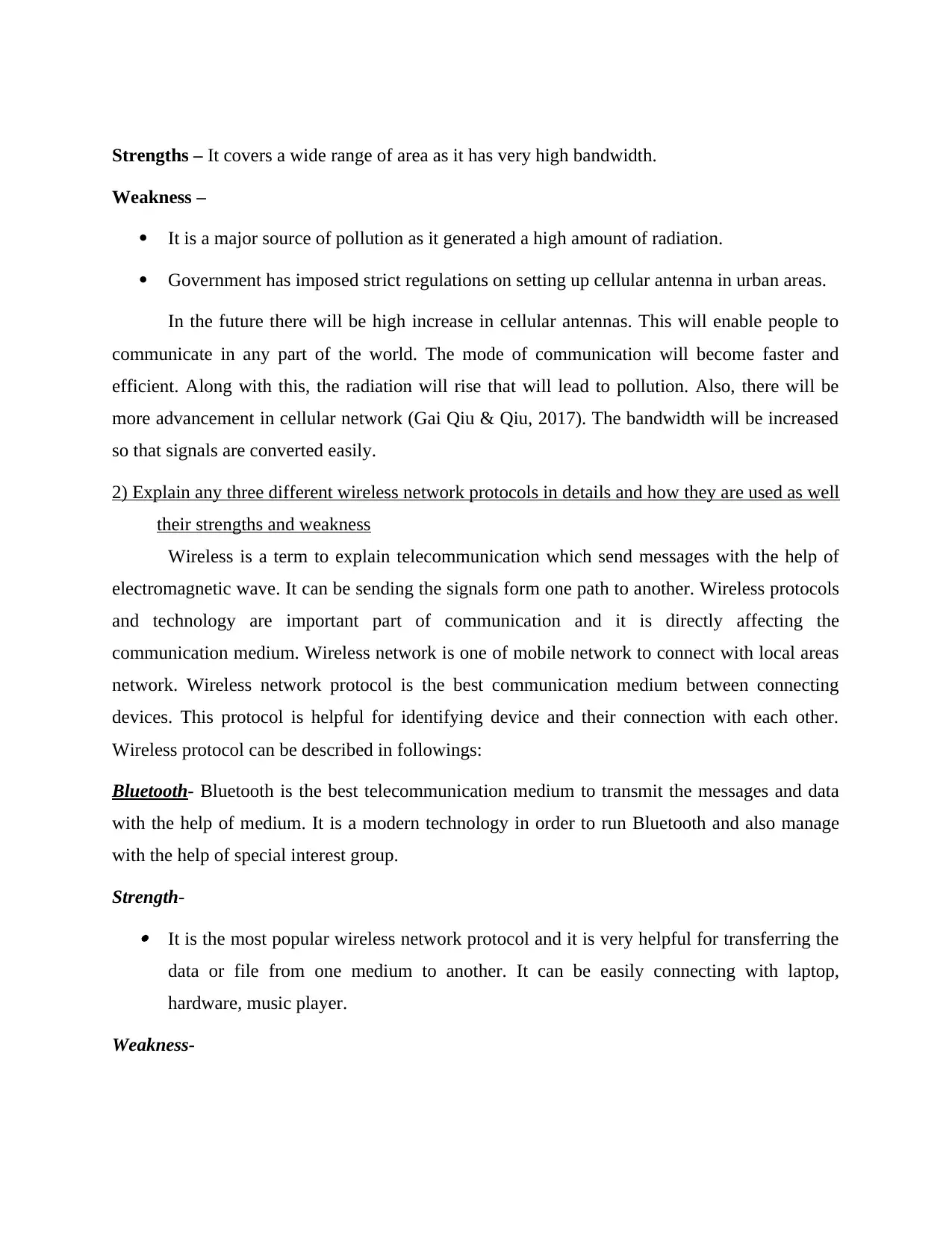
Strengths – It covers a wide range of area as it has very high bandwidth.
Weakness –
It is a major source of pollution as it generated a high amount of radiation.
Government has imposed strict regulations on setting up cellular antenna in urban areas.
In the future there will be high increase in cellular antennas. This will enable people to
communicate in any part of the world. The mode of communication will become faster and
efficient. Along with this, the radiation will rise that will lead to pollution. Also, there will be
more advancement in cellular network (Gai Qiu & Qiu, 2017). The bandwidth will be increased
so that signals are converted easily.
2) Explain any three different wireless network protocols in details and how they are used as well
their strengths and weakness
Wireless is a term to explain telecommunication which send messages with the help of
electromagnetic wave. It can be sending the signals form one path to another. Wireless protocols
and technology are important part of communication and it is directly affecting the
communication medium. Wireless network is one of mobile network to connect with local areas
network. Wireless network protocol is the best communication medium between connecting
devices. This protocol is helpful for identifying device and their connection with each other.
Wireless protocol can be described in followings:
Bluetooth- Bluetooth is the best telecommunication medium to transmit the messages and data
with the help of medium. It is a modern technology in order to run Bluetooth and also manage
with the help of special interest group.
Strength- It is the most popular wireless network protocol and it is very helpful for transferring the
data or file from one medium to another. It can be easily connecting with laptop,
hardware, music player.
Weakness-
Weakness –
It is a major source of pollution as it generated a high amount of radiation.
Government has imposed strict regulations on setting up cellular antenna in urban areas.
In the future there will be high increase in cellular antennas. This will enable people to
communicate in any part of the world. The mode of communication will become faster and
efficient. Along with this, the radiation will rise that will lead to pollution. Also, there will be
more advancement in cellular network (Gai Qiu & Qiu, 2017). The bandwidth will be increased
so that signals are converted easily.
2) Explain any three different wireless network protocols in details and how they are used as well
their strengths and weakness
Wireless is a term to explain telecommunication which send messages with the help of
electromagnetic wave. It can be sending the signals form one path to another. Wireless protocols
and technology are important part of communication and it is directly affecting the
communication medium. Wireless network is one of mobile network to connect with local areas
network. Wireless network protocol is the best communication medium between connecting
devices. This protocol is helpful for identifying device and their connection with each other.
Wireless protocol can be described in followings:
Bluetooth- Bluetooth is the best telecommunication medium to transmit the messages and data
with the help of medium. It is a modern technology in order to run Bluetooth and also manage
with the help of special interest group.
Strength- It is the most popular wireless network protocol and it is very helpful for transferring the
data or file from one medium to another. It can be easily connecting with laptop,
hardware, music player.
Weakness-
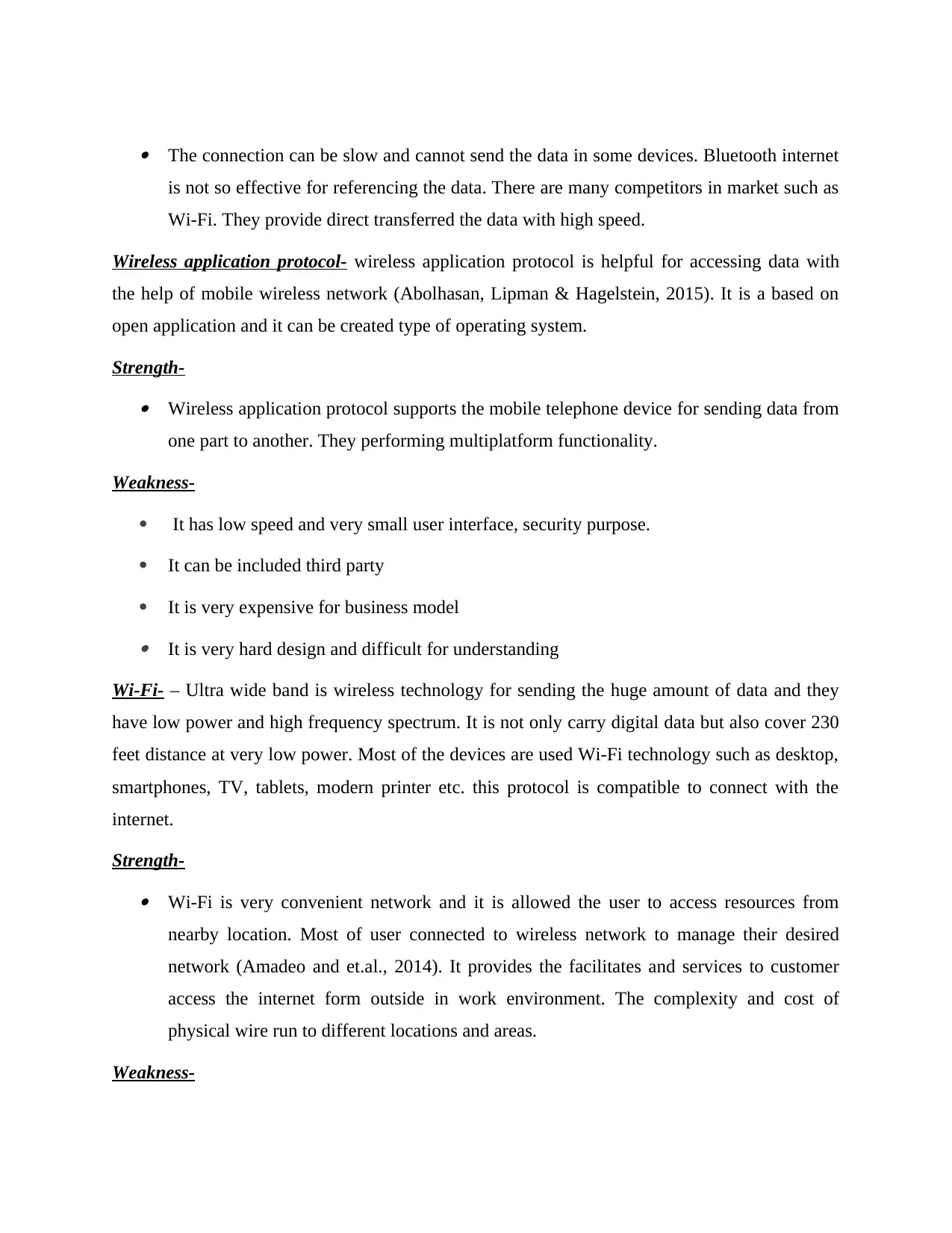
The connection can be slow and cannot send the data in some devices. Bluetooth internet
is not so effective for referencing the data. There are many competitors in market such as
Wi-Fi. They provide direct transferred the data with high speed.
Wireless application protocol- wireless application protocol is helpful for accessing data with
the help of mobile wireless network (Abolhasan, Lipman & Hagelstein, 2015). It is a based on
open application and it can be created type of operating system.
Strength- Wireless application protocol supports the mobile telephone device for sending data from
one part to another. They performing multiplatform functionality.
Weakness-
It has low speed and very small user interface, security purpose.
It can be included third party
It is very expensive for business model It is very hard design and difficult for understanding
Wi-Fi- – Ultra wide band is wireless technology for sending the huge amount of data and they
have low power and high frequency spectrum. It is not only carry digital data but also cover 230
feet distance at very low power. Most of the devices are used Wi-Fi technology such as desktop,
smartphones, TV, tablets, modern printer etc. this protocol is compatible to connect with the
internet.
Strength- Wi-Fi is very convenient network and it is allowed the user to access resources from
nearby location. Most of user connected to wireless network to manage their desired
network (Amadeo and et.al., 2014). It provides the facilitates and services to customer
access the internet form outside in work environment. The complexity and cost of
physical wire run to different locations and areas.
Weakness-
is not so effective for referencing the data. There are many competitors in market such as
Wi-Fi. They provide direct transferred the data with high speed.
Wireless application protocol- wireless application protocol is helpful for accessing data with
the help of mobile wireless network (Abolhasan, Lipman & Hagelstein, 2015). It is a based on
open application and it can be created type of operating system.
Strength- Wireless application protocol supports the mobile telephone device for sending data from
one part to another. They performing multiplatform functionality.
Weakness-
It has low speed and very small user interface, security purpose.
It can be included third party
It is very expensive for business model It is very hard design and difficult for understanding
Wi-Fi- – Ultra wide band is wireless technology for sending the huge amount of data and they
have low power and high frequency spectrum. It is not only carry digital data but also cover 230
feet distance at very low power. Most of the devices are used Wi-Fi technology such as desktop,
smartphones, TV, tablets, modern printer etc. this protocol is compatible to connect with the
internet.
Strength- Wi-Fi is very convenient network and it is allowed the user to access resources from
nearby location. Most of user connected to wireless network to manage their desired
network (Amadeo and et.al., 2014). It provides the facilitates and services to customer
access the internet form outside in work environment. The complexity and cost of
physical wire run to different locations and areas.
Weakness-
⊘ This is a preview!⊘
Do you want full access?
Subscribe today to unlock all pages.

Trusted by 1+ million students worldwide
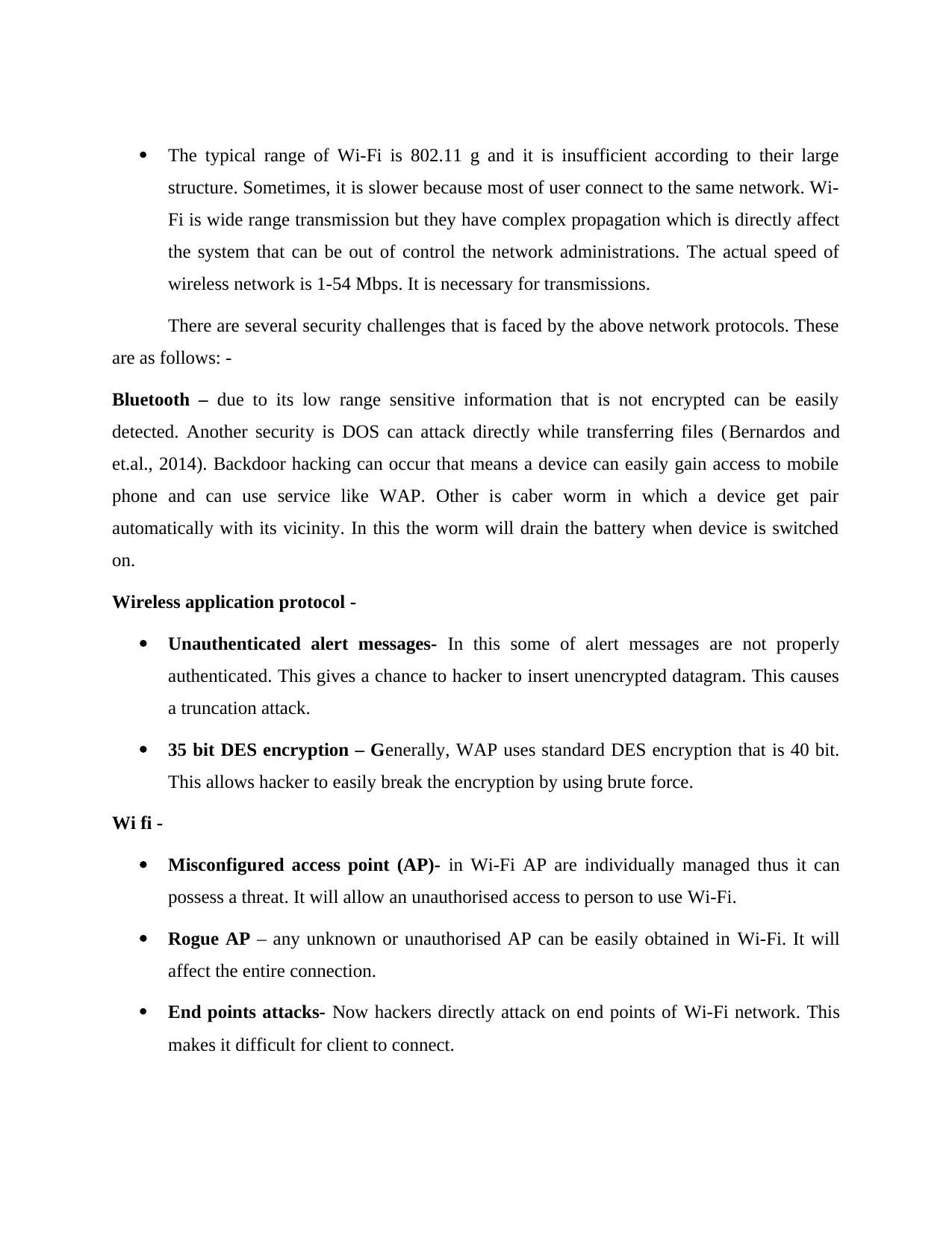
The typical range of Wi-Fi is 802.11 g and it is insufficient according to their large
structure. Sometimes, it is slower because most of user connect to the same network. Wi-
Fi is wide range transmission but they have complex propagation which is directly affect
the system that can be out of control the network administrations. The actual speed of
wireless network is 1-54 Mbps. It is necessary for transmissions.
There are several security challenges that is faced by the above network protocols. These
are as follows: -
Bluetooth – due to its low range sensitive information that is not encrypted can be easily
detected. Another security is DOS can attack directly while transferring files (Bernardos and
et.al., 2014). Backdoor hacking can occur that means a device can easily gain access to mobile
phone and can use service like WAP. Other is caber worm in which a device get pair
automatically with its vicinity. In this the worm will drain the battery when device is switched
on.
Wireless application protocol -
Unauthenticated alert messages- In this some of alert messages are not properly
authenticated. This gives a chance to hacker to insert unencrypted datagram. This causes
a truncation attack.
35 bit DES encryption – Generally, WAP uses standard DES encryption that is 40 bit.
This allows hacker to easily break the encryption by using brute force.
Wi fi -
Misconfigured access point (AP)- in Wi-Fi AP are individually managed thus it can
possess a threat. It will allow an unauthorised access to person to use Wi-Fi.
Rogue AP – any unknown or unauthorised AP can be easily obtained in Wi-Fi. It will
affect the entire connection.
End points attacks- Now hackers directly attack on end points of Wi-Fi network. This
makes it difficult for client to connect.
structure. Sometimes, it is slower because most of user connect to the same network. Wi-
Fi is wide range transmission but they have complex propagation which is directly affect
the system that can be out of control the network administrations. The actual speed of
wireless network is 1-54 Mbps. It is necessary for transmissions.
There are several security challenges that is faced by the above network protocols. These
are as follows: -
Bluetooth – due to its low range sensitive information that is not encrypted can be easily
detected. Another security is DOS can attack directly while transferring files (Bernardos and
et.al., 2014). Backdoor hacking can occur that means a device can easily gain access to mobile
phone and can use service like WAP. Other is caber worm in which a device get pair
automatically with its vicinity. In this the worm will drain the battery when device is switched
on.
Wireless application protocol -
Unauthenticated alert messages- In this some of alert messages are not properly
authenticated. This gives a chance to hacker to insert unencrypted datagram. This causes
a truncation attack.
35 bit DES encryption – Generally, WAP uses standard DES encryption that is 40 bit.
This allows hacker to easily break the encryption by using brute force.
Wi fi -
Misconfigured access point (AP)- in Wi-Fi AP are individually managed thus it can
possess a threat. It will allow an unauthorised access to person to use Wi-Fi.
Rogue AP – any unknown or unauthorised AP can be easily obtained in Wi-Fi. It will
affect the entire connection.
End points attacks- Now hackers directly attack on end points of Wi-Fi network. This
makes it difficult for client to connect.
Paraphrase This Document
Need a fresh take? Get an instant paraphrase of this document with our AI Paraphraser
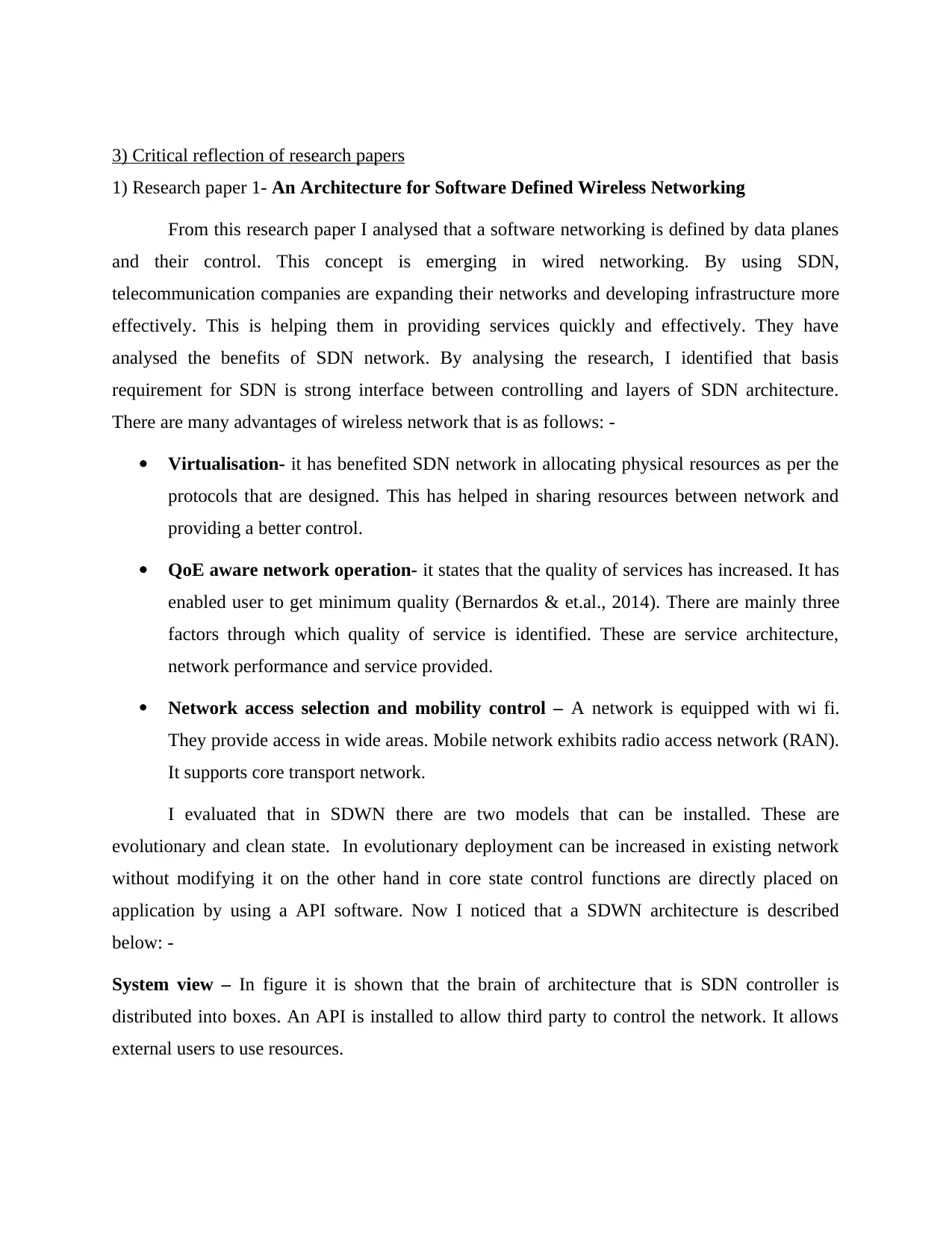
3) Critical reflection of research papers
1) Research paper 1- An Architecture for Software Defined Wireless Networking
From this research paper I analysed that a software networking is defined by data planes
and their control. This concept is emerging in wired networking. By using SDN,
telecommunication companies are expanding their networks and developing infrastructure more
effectively. This is helping them in providing services quickly and effectively. They have
analysed the benefits of SDN network. By analysing the research, I identified that basis
requirement for SDN is strong interface between controlling and layers of SDN architecture.
There are many advantages of wireless network that is as follows: -
Virtualisation- it has benefited SDN network in allocating physical resources as per the
protocols that are designed. This has helped in sharing resources between network and
providing a better control.
QoE aware network operation- it states that the quality of services has increased. It has
enabled user to get minimum quality (Bernardos & et.al., 2014). There are mainly three
factors through which quality of service is identified. These are service architecture,
network performance and service provided.
Network access selection and mobility control – A network is equipped with wi fi.
They provide access in wide areas. Mobile network exhibits radio access network (RAN).
It supports core transport network.
I evaluated that in SDWN there are two models that can be installed. These are
evolutionary and clean state. In evolutionary deployment can be increased in existing network
without modifying it on the other hand in core state control functions are directly placed on
application by using a API software. Now I noticed that a SDWN architecture is described
below: -
System view – In figure it is shown that the brain of architecture that is SDN controller is
distributed into boxes. An API is installed to allow third party to control the network. It allows
external users to use resources.
1) Research paper 1- An Architecture for Software Defined Wireless Networking
From this research paper I analysed that a software networking is defined by data planes
and their control. This concept is emerging in wired networking. By using SDN,
telecommunication companies are expanding their networks and developing infrastructure more
effectively. This is helping them in providing services quickly and effectively. They have
analysed the benefits of SDN network. By analysing the research, I identified that basis
requirement for SDN is strong interface between controlling and layers of SDN architecture.
There are many advantages of wireless network that is as follows: -
Virtualisation- it has benefited SDN network in allocating physical resources as per the
protocols that are designed. This has helped in sharing resources between network and
providing a better control.
QoE aware network operation- it states that the quality of services has increased. It has
enabled user to get minimum quality (Bernardos & et.al., 2014). There are mainly three
factors through which quality of service is identified. These are service architecture,
network performance and service provided.
Network access selection and mobility control – A network is equipped with wi fi.
They provide access in wide areas. Mobile network exhibits radio access network (RAN).
It supports core transport network.
I evaluated that in SDWN there are two models that can be installed. These are
evolutionary and clean state. In evolutionary deployment can be increased in existing network
without modifying it on the other hand in core state control functions are directly placed on
application by using a API software. Now I noticed that a SDWN architecture is described
below: -
System view – In figure it is shown that the brain of architecture that is SDN controller is
distributed into boxes. An API is installed to allow third party to control the network. It allows
external users to use resources.
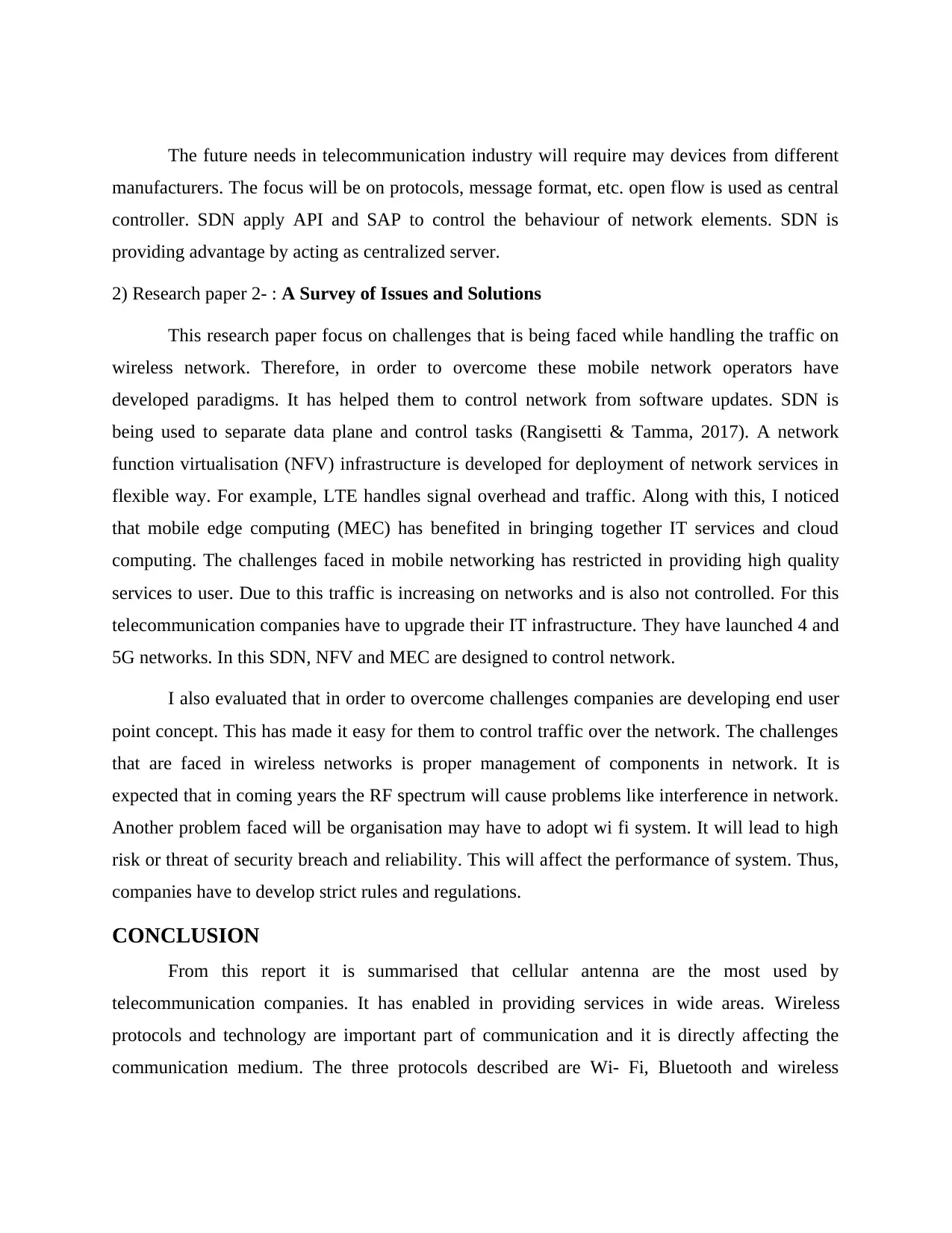
The future needs in telecommunication industry will require may devices from different
manufacturers. The focus will be on protocols, message format, etc. open flow is used as central
controller. SDN apply API and SAP to control the behaviour of network elements. SDN is
providing advantage by acting as centralized server.
2) Research paper 2- : A Survey of Issues and Solutions
This research paper focus on challenges that is being faced while handling the traffic on
wireless network. Therefore, in order to overcome these mobile network operators have
developed paradigms. It has helped them to control network from software updates. SDN is
being used to separate data plane and control tasks (Rangisetti & Tamma, 2017). A network
function virtualisation (NFV) infrastructure is developed for deployment of network services in
flexible way. For example, LTE handles signal overhead and traffic. Along with this, I noticed
that mobile edge computing (MEC) has benefited in bringing together IT services and cloud
computing. The challenges faced in mobile networking has restricted in providing high quality
services to user. Due to this traffic is increasing on networks and is also not controlled. For this
telecommunication companies have to upgrade their IT infrastructure. They have launched 4 and
5G networks. In this SDN, NFV and MEC are designed to control network.
I also evaluated that in order to overcome challenges companies are developing end user
point concept. This has made it easy for them to control traffic over the network. The challenges
that are faced in wireless networks is proper management of components in network. It is
expected that in coming years the RF spectrum will cause problems like interference in network.
Another problem faced will be organisation may have to adopt wi fi system. It will lead to high
risk or threat of security breach and reliability. This will affect the performance of system. Thus,
companies have to develop strict rules and regulations.
CONCLUSION
From this report it is summarised that cellular antenna are the most used by
telecommunication companies. It has enabled in providing services in wide areas. Wireless
protocols and technology are important part of communication and it is directly affecting the
communication medium. The three protocols described are Wi- Fi, Bluetooth and wireless
manufacturers. The focus will be on protocols, message format, etc. open flow is used as central
controller. SDN apply API and SAP to control the behaviour of network elements. SDN is
providing advantage by acting as centralized server.
2) Research paper 2- : A Survey of Issues and Solutions
This research paper focus on challenges that is being faced while handling the traffic on
wireless network. Therefore, in order to overcome these mobile network operators have
developed paradigms. It has helped them to control network from software updates. SDN is
being used to separate data plane and control tasks (Rangisetti & Tamma, 2017). A network
function virtualisation (NFV) infrastructure is developed for deployment of network services in
flexible way. For example, LTE handles signal overhead and traffic. Along with this, I noticed
that mobile edge computing (MEC) has benefited in bringing together IT services and cloud
computing. The challenges faced in mobile networking has restricted in providing high quality
services to user. Due to this traffic is increasing on networks and is also not controlled. For this
telecommunication companies have to upgrade their IT infrastructure. They have launched 4 and
5G networks. In this SDN, NFV and MEC are designed to control network.
I also evaluated that in order to overcome challenges companies are developing end user
point concept. This has made it easy for them to control traffic over the network. The challenges
that are faced in wireless networks is proper management of components in network. It is
expected that in coming years the RF spectrum will cause problems like interference in network.
Another problem faced will be organisation may have to adopt wi fi system. It will lead to high
risk or threat of security breach and reliability. This will affect the performance of system. Thus,
companies have to develop strict rules and regulations.
CONCLUSION
From this report it is summarised that cellular antenna are the most used by
telecommunication companies. It has enabled in providing services in wide areas. Wireless
protocols and technology are important part of communication and it is directly affecting the
communication medium. The three protocols described are Wi- Fi, Bluetooth and wireless
⊘ This is a preview!⊘
Do you want full access?
Subscribe today to unlock all pages.

Trusted by 1+ million students worldwide
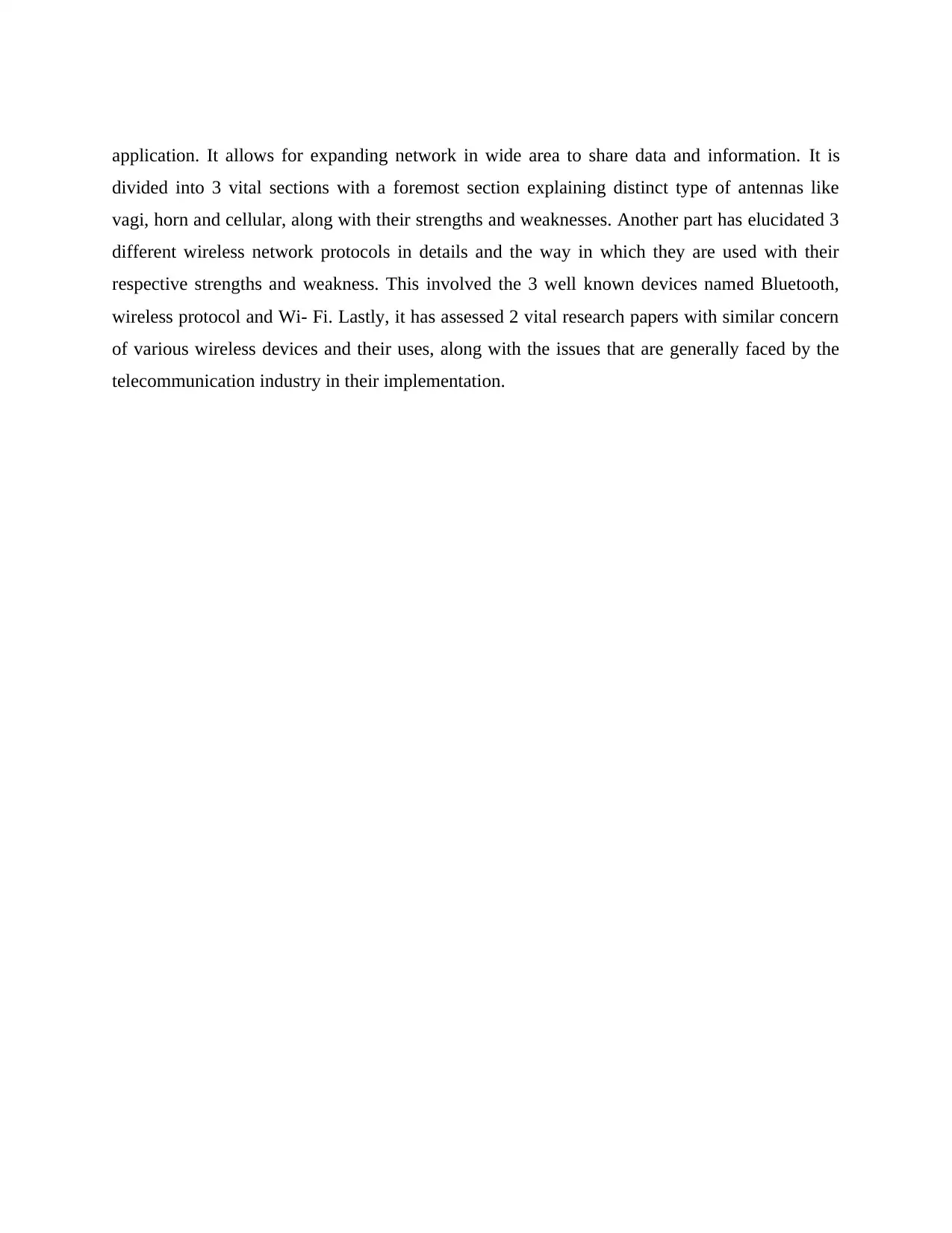
application. It allows for expanding network in wide area to share data and information. It is
divided into 3 vital sections with a foremost section explaining distinct type of antennas like
vagi, horn and cellular, along with their strengths and weaknesses. Another part has elucidated 3
different wireless network protocols in details and the way in which they are used with their
respective strengths and weakness. This involved the 3 well known devices named Bluetooth,
wireless protocol and Wi- Fi. Lastly, it has assessed 2 vital research papers with similar concern
of various wireless devices and their uses, along with the issues that are generally faced by the
telecommunication industry in their implementation.
divided into 3 vital sections with a foremost section explaining distinct type of antennas like
vagi, horn and cellular, along with their strengths and weaknesses. Another part has elucidated 3
different wireless network protocols in details and the way in which they are used with their
respective strengths and weakness. This involved the 3 well known devices named Bluetooth,
wireless protocol and Wi- Fi. Lastly, it has assessed 2 vital research papers with similar concern
of various wireless devices and their uses, along with the issues that are generally faced by the
telecommunication industry in their implementation.
Paraphrase This Document
Need a fresh take? Get an instant paraphrase of this document with our AI Paraphraser
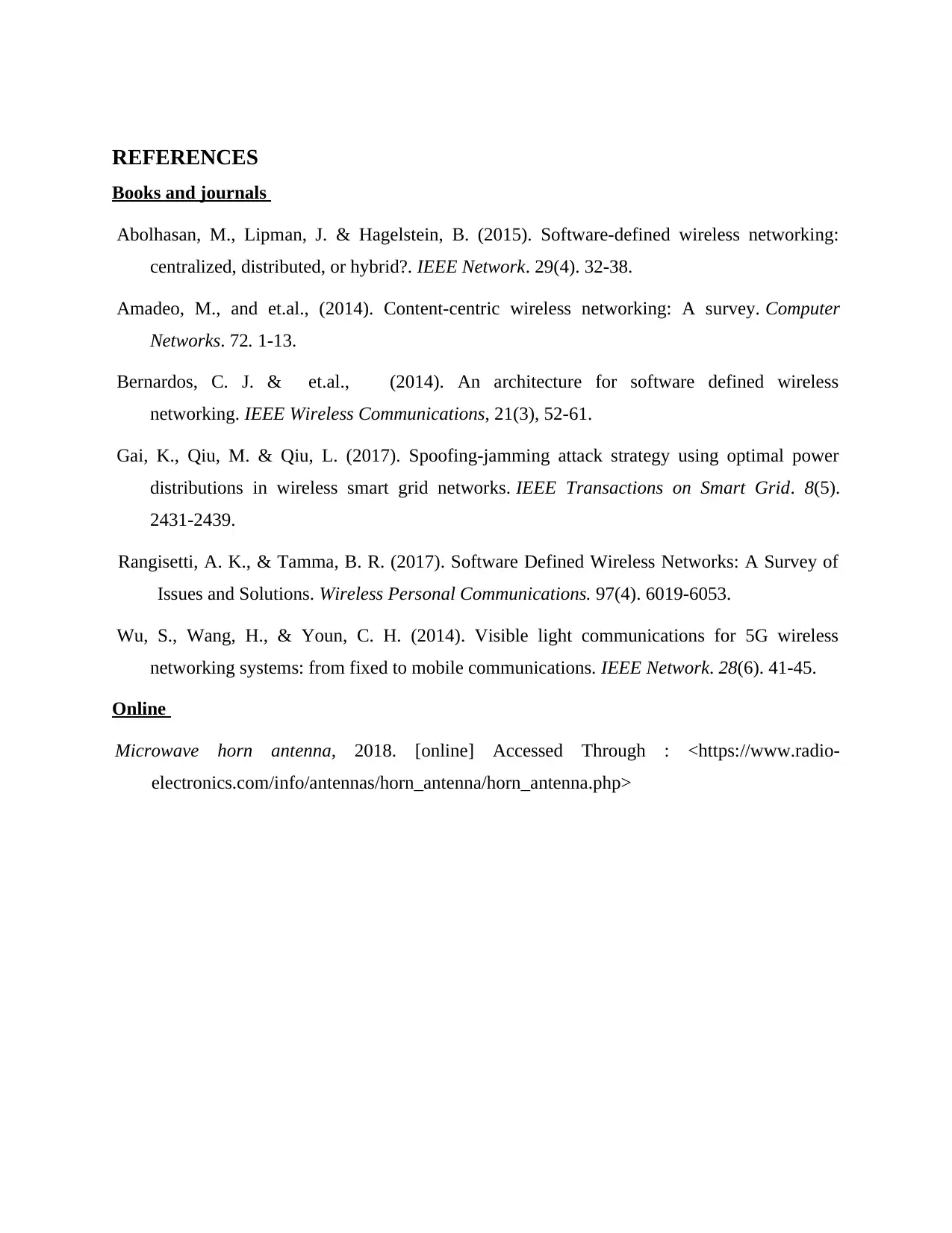
REFERENCES
Books and journals
Abolhasan, M., Lipman, J. & Hagelstein, B. (2015). Software-defined wireless networking:
centralized, distributed, or hybrid?. IEEE Network. 29(4). 32-38.
Amadeo, M., and et.al., (2014). Content-centric wireless networking: A survey. Computer
Networks. 72. 1-13.
Bernardos, C. J. & et.al., (2014). An architecture for software defined wireless
networking. IEEE Wireless Communications, 21(3), 52-61.
Gai, K., Qiu, M. & Qiu, L. (2017). Spoofing-jamming attack strategy using optimal power
distributions in wireless smart grid networks. IEEE Transactions on Smart Grid. 8(5).
2431-2439.
Rangisetti, A. K., & Tamma, B. R. (2017). Software Defined Wireless Networks: A Survey of
Issues and Solutions. Wireless Personal Communications. 97(4). 6019-6053.
Wu, S., Wang, H., & Youn, C. H. (2014). Visible light communications for 5G wireless
networking systems: from fixed to mobile communications. IEEE Network. 28(6). 41-45.
Online
Microwave horn antenna, 2018. [online] Accessed Through : <https://www.radio-
electronics.com/info/antennas/horn_antenna/horn_antenna.php>
Books and journals
Abolhasan, M., Lipman, J. & Hagelstein, B. (2015). Software-defined wireless networking:
centralized, distributed, or hybrid?. IEEE Network. 29(4). 32-38.
Amadeo, M., and et.al., (2014). Content-centric wireless networking: A survey. Computer
Networks. 72. 1-13.
Bernardos, C. J. & et.al., (2014). An architecture for software defined wireless
networking. IEEE Wireless Communications, 21(3), 52-61.
Gai, K., Qiu, M. & Qiu, L. (2017). Spoofing-jamming attack strategy using optimal power
distributions in wireless smart grid networks. IEEE Transactions on Smart Grid. 8(5).
2431-2439.
Rangisetti, A. K., & Tamma, B. R. (2017). Software Defined Wireless Networks: A Survey of
Issues and Solutions. Wireless Personal Communications. 97(4). 6019-6053.
Wu, S., Wang, H., & Youn, C. H. (2014). Visible light communications for 5G wireless
networking systems: from fixed to mobile communications. IEEE Network. 28(6). 41-45.
Online
Microwave horn antenna, 2018. [online] Accessed Through : <https://www.radio-
electronics.com/info/antennas/horn_antenna/horn_antenna.php>

⊘ This is a preview!⊘
Do you want full access?
Subscribe today to unlock all pages.

Trusted by 1+ million students worldwide
1 out of 12
Related Documents
Your All-in-One AI-Powered Toolkit for Academic Success.
+13062052269
info@desklib.com
Available 24*7 on WhatsApp / Email
![[object Object]](/_next/static/media/star-bottom.7253800d.svg)
Unlock your academic potential
Copyright © 2020–2025 A2Z Services. All Rights Reserved. Developed and managed by ZUCOL.




